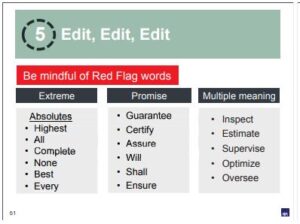10 Steps for Optimal Email Communication
Email communication has become the primary way engineers communicate with clients, contractors, and consultants. It can become habitual to send off a hasty request or an immediate reply without careful consideration of the language used and whether the topic should be handled via email or whether a phone call may be more appropriate. What standards do you use when deciding what gets addressed via email and how can you use emails appropriately and without unnecessary risk?
In the August 2020 SE University session, Jamie Piercy, from PCIA, presented 7 Deadly Email Sins. Jamie explained some best practices for writing well-crafted emails that are clear, concise and actionable. Jamie also presented examples from actual claims cases and disputes to identify inappropriate text and discussed alternative language in emails. She helped participants to recognize email communication which could create a misunderstanding, exacerbate an issue, or implicate the sender in a claim. Alternate methods of communication were also discussed and recommended in some instances.
Jamie offered 10 steps for best practices when writing emails:
- Know your purpose – Jamie recommends emails be used for the purposes shown below. Any other topics of sensitive nature which may be contentious should be dealt with verbally.

- Strong subject line – Your subject line should clearly state the key message of the email to compel the recipient to open the email. When replying to an email thread, you should create a new message with a new subject line to address the current issue to allow for quick reference in the future..
- Bottom line upfront – Avoid burying any conclusions or recommendations within a lengthy email. The intent should be stated within the first two lines of your email.
- One topic – Keep your emails simple and focused on one issue, decision, request or question.
- Edit – Avoid the use of ‘red flag’ words which can raise the standard of care on projects.

- Concise – Aim for well-organized emails with short sentences that can be scanned quickly.
- Clear Ending – Clearly tell the recipient what they need to do or not do in response to the email.
- Proofread – Checking for spelling and grammar is necessary, but using tools to delay your sent messages or waiting to insert the recipient’s name until the email is complete can prevent incomplete emails from being sent.
- Confidential – ALL EMAILS ARE DISCOVERABLE. Even internal discussions should be treated as though they will be read by the client, and should not contain private, confidential or incriminating information. Care should also be taken to note who is included when you ‘Reply All’ to an email, and whether each person should be included.
- Litmus Test – Jamie suggests asking yourself whether the email may be surprising to the recipient. Should you wait to send the email when you feel less emotional? Would you feel comfortable receiving the email yourself, or delivering it face to face, or reading it aloud on a witness stand? Some sensitive topics should warrant a phone conversation or face to face meeting.
While Jamie focused mainly on email communication, the same rules should be applied to any written form of communication, including text messages and office chat features. While texts and chats can be useful for quick comments, they should be avoided when making changes or revisions on a project or resolving problems. Email should be used to document such critical information. Using these 10 steps to guide your email communication can reduce confusion, enhance your reputation, and prevent costly errors if claims are brought on a project.


There are no comments yet, but you can be the first